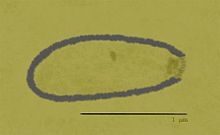Pithovirus
| Pithovirus | |
|---|---|

| |
| Virus classification | |
| Group: | Group I (
dsDNA ) |
| Order: | Megavirales |
| Family: | Pithoviridae
|
| Genus: | Pithovirus
|
| Species | |
| |
Pithovirus, first described in a 2014 paper, is a genus of
Description
The genus name Pithovirus, a reference to large storage containers of ancient Greece known as
Pithovirus has a thick, oval wall with an opening at one end. Internally, its structure resembles a honeycomb.[1]
The
Replication
Pithovirus'
Discovery
Pithovirus sibericum was discovered in a 30,000-year-old sample of
Although the virus is harmless to humans, its viability after being frozen for millennia has raised concerns that global climate change and tundra drilling operations could lead to previously undiscovered and potentially pathogenic viruses being unearthed.[4] However, other scientists dispute that this scenario poses a real threat.[1]
A modern species in the genus, Pithovirus massiliensis, was isolated in 2016. The core features such as the order of ORFs and orphan genes (ORFans) are well conserved between the two known species.[3]
Evolution
The rate of mutation of the genome has been estimated to be 2.23 × 10−6 substitutions/site/year.[12] The authors have suggested that the two known Pithoviruses diverged around two hundred thousand years ago.
See also
- DNA virus
- Largest organisms
- List of longest-living organisms
- List of viruses
- Microbiology
- Virology
- Virus classification
References
- ^ S2CID 87146458.
- ^ a b Morelle, Rebecca (3 March 2014). "30,000-year-old giant virus 'comes back to life'". BBC News.
- ^ PMID 27389688.
- ^ a b c d Sirucek, Stefan (3 March 2014). "Ancient "Giant Virus" Revived From Siberian Permafrost". National Geographic. Archived from the original on 4 March 2014.
- ^ Brumfiel, Geoff (18 July 2013). "World's Biggest Virus May Have Ancient Roots". National Public Radio.
- ^ a b c d Racaniello, Vincent (4 March 2014). "Pithovirus: Bigger than Pandoravirus with a smaller genome". Virology Blog.
- ^ PMID 24591590.
- ^ "Pithovirus sibericum". Swiss Institute of Bioinformatics (SIB). Retrieved 10 March 2014.
- ^ Coghlan, Andy (3 March 2014). "Biggest-ever virus revived from Stone Age permafrost". NewScientist. Archived from the original on 5 March 2014.
- ^ Pappas, Stephanie (16 September 2015). "Frozen Giant Virus Still Infectious After 30,000 Years". Yahoo News. Retrieved 20 September 2015.
- ^ Zimmer, Carl (3 March 2014). "Out of Siberian Ice, a Virus Revived". The New York Times.
- PMID 29511572.
External links
- Viralzone: Pithovirus
- "Pithovirus sibericum". NCBI Taxonomy Browser. 1450746.

